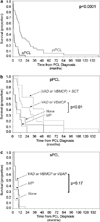Genetic aberrations and survival in plasma cell leukemia
- PMID: 18216867
- PMCID: PMC3893817
- DOI: 10.1038/leu.2008.4
Genetic aberrations and survival in plasma cell leukemia
Abstract
Plasma cell leukemia (PCL) is an aggressive and rare hematological malignancy that originates either as primary disease (pPCL) or as a secondary leukemic transformation (sPCL) of multiple myeloma (MM). We report here the genetic aberrations and survival of 80 patients with pPCL or sPCL and make comparisons with 439 cases of MM. pPCL presents a decade earlier than sPCL (54.7 vs 65.3 years) and is associated with longer median overall survival (11.1 vs 1.3 months; P<0.001). 14q32 (IgH) translocations are highly prevalent in both sPCL and pPCL (82-87%); in pPCL IgH translocations almost exclusively involve 11q13 (CCND1), supporting a central etiological role, while in sPCL multiple partner oncogenes are involved, including 11q13, 4p16 (FGFR3/MMSET) and 16q23 (MAF), recapitulating MM. Both show ubiquitous inactivation of TP53 (pPCL 56%; sPCL 83%) by coding mutation or 17p13 deletion; complemented by p14ARF epigenetic silencing in sPCL (29%). Both show frequent N-RAS or K-RAS mutation. Poor survival in pPCL was predicted by MYC translocation (P=0.006). Survival in sPCL was consistently short. Overall pPCL and sPCL are different disorders with distinct natural histories, genetics and survival.
Figures

References
-
- Kyle RA, Maldonado JE, Bayrd ED. Plasma cell leukemia. Report on 17 cases. Arch Intern Med. 1974;133:813–818. - PubMed
-
- Noel P, Kyle RA. Plasma cell leukemia: an evaluation of response to therapy. Am J Med. 1987;83:1062–1068. - PubMed
-
- Dimopoulos MA, Palumbo A, Delasalle KB, Alexanian R. Primary plasma cell leukaemia. Br J Haematol. 1994;88:754–759. - PubMed
-
- Jaffe ES, Harris NL, Stein H, Vardiman JW. World Health Organization Classification of Tumours. Pathology and Genetics of Tumours of Haematopoietic and Lymphoid Tissues. Lyon: IARC Press; 2001.
-
- Avet-Loiseau H, Daviet A, Brigaudeau C, Callet-Bauchu E, Terre C, Lafage-Pochitaloff M, et al. Cytogenetic, interphase, and multicolor fluorescence in situ hybridization analyses in primary plasma cell leukemia. Blood. 2001;97:822–825. - PubMed
Publication types
MeSH terms
Grants and funding
LinkOut - more resources
Full Text Sources
Other Literature Sources
Research Materials
Miscellaneous

